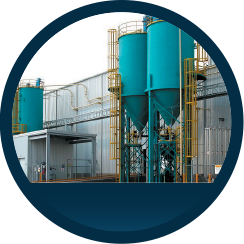
The Green Sand Molding Process
The term Green Sand denotes the presence of moisture in molding sand and indicates that the mold is not baked or dried. Raw sand is mined and then processed to give it a consistent distribution of grain sizing. When processed for molding, organic clays are added to bond the grains together.
A coal dust (known as Sea Coal) is added to control casting quality during expansion of the sand when hot metals are poured into the molds. Other additives, such as pitch, cellulose and silica flour, are also used. The additive used depends on the metal cast. The sand is blended in a mullor or mixer, where the water and the additives are blended with the sand.
The sand is then ready to be used to make a mold. There are several methods of molding but all methods squeeze or compact the sand against a pattern to make an impression of the part to be cast. The patterns are separated from the mold halves or mold cake and the mold is then closed creating a part cavity. Types of molding range from automatic high-pressure high-speed molding, automatic match plate molding, automatic tight flask molding (used for large molds) and jolt squeeze molding. Large molds are also made on the floor and rammed up by hand. Today, molding is primarily done automatically and the molds are placed on mold handling equipment to be poured, to allow the castings to solidify and to cool. Mold handling equipment configurations include indexing lines, looping lines and mold car lines. Pouring of the metal can be accomplished automatically with a pouring furnace or transported to the molds in ladles. Ladle capacities can range in size from 100 pounds up to several tons.
After the metal in the mold has solidified and cooled, the mold is dumped onto a shakeout that separates the castings from the sand. The shakeout process can be performed with a wide variety of equipment. The casting is then desprued (separated from the runner system). The runner system is used to get metal into the casting cavity. The runner system is sent back to the melt department for reuse and the castings are sent to the finishing process. The sand is reused after it is screened and cooled. New sand is also added based upon a ratio of the amount of metal poured into a given quantity of sand.
Casting finishing normally starts with shot blasting to remove sand that is stuck to the casting. The finishing area can be highly automated, using robots and Vision systems, or it can be a simple manually operated hand system. Normal types of finishing work include wheel grinding, belt grinding, trim press cutting, saw cutting, air arch cutting and hand grinding. Method used depends on the metal cast and the size of the casting.
Vulcan Engineering can design and build a complete green sand casting facility as well as up grades and additions to existing facilities. We also offer a large line of equipment for the green sand foundries. More Info >>
